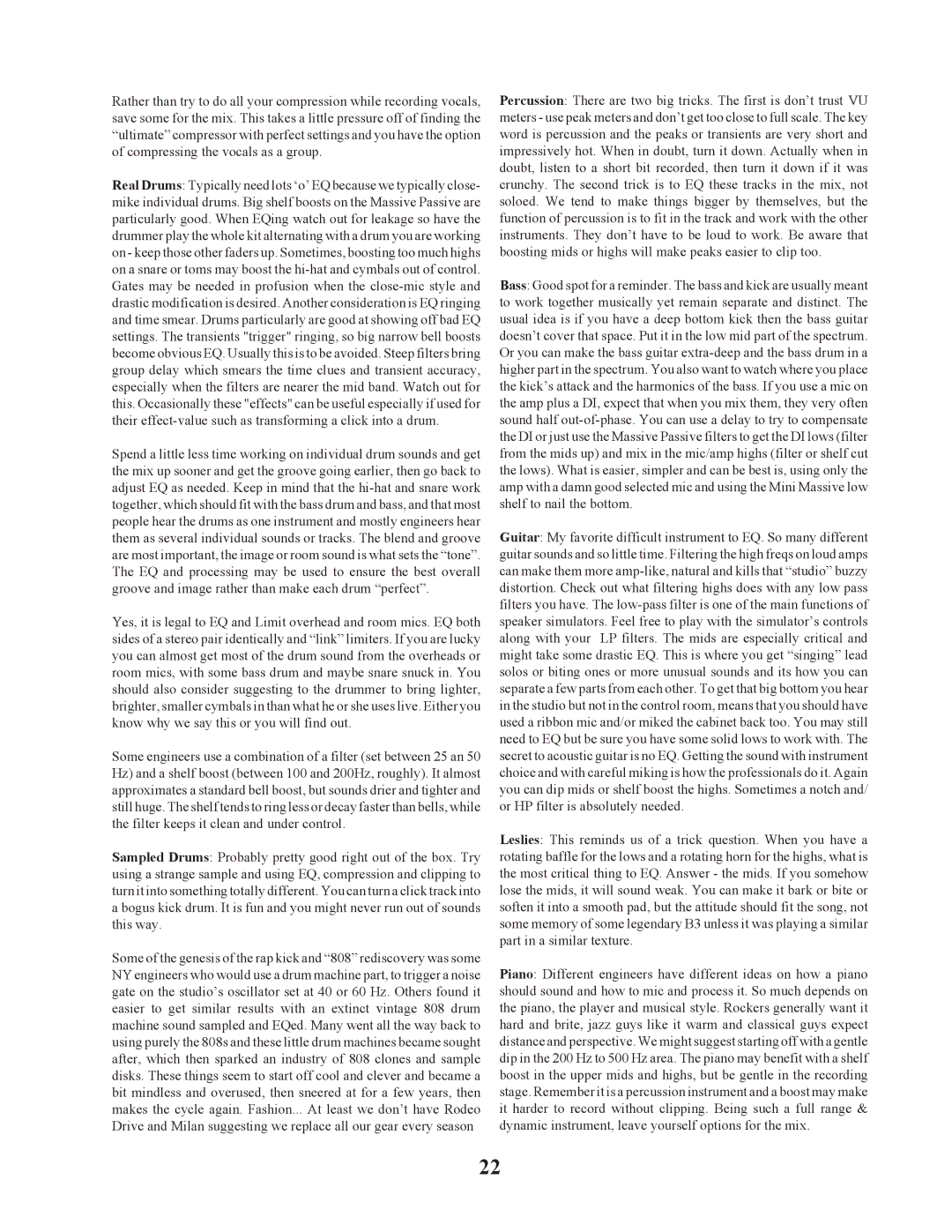Rather than try to do all your compression while recording vocals, save some for the mix. This takes a little pressure off of finding the “ultimate” compressor with perfect settings and you have the option of compressing the vocals as a group.
Real Drums: Typically need lots ‘o’ EQ because we typically close- mike individual drums. Big shelf boosts on the Massive Passive are particularly good. When EQing watch out for leakage so have the drummer play the whole kit alternating with a drum you are working on - keep those other faders up. Sometimes, boosting too much highs on a snare or toms may boost the
Spend a little less time working on individual drum sounds and get the mix up sooner and get the groove going earlier, then go back to adjust EQ as needed. Keep in mind that the
Yes, it is legal to EQ and Limit overhead and room mics. EQ both sides of a stereo pair identically and “link” limiters. If you are lucky you can almost get most of the drum sound from the overheads or room mics, with some bass drum and maybe snare snuck in. You should also consider suggesting to the drummer to bring lighter, brighter, smaller cymbals in than what he or she uses live. Either you know why we say this or you will find out.
Some engineers use a combination of a filter (set between 25 an 50 Hz) and a shelf boost (between 100 and 200Hz, roughly). It almost approximates a standard bell boost, but sounds drier and tighter and still huge. The shelf tends to ring less or decay faster than bells, while the filter keeps it clean and under control.
Sampled Drums: Probably pretty good right out of the box. Try using a strange sample and using EQ, compression and clipping to turn it into something totally different. You can turn a click track into a bogus kick drum. It is fun and you might never run out of sounds this way.
Some of the genesis of the rap kick and “808” rediscovery was some NY engineers who would use a drum machine part, to trigger a noise gate on the studio’s oscillator set at 40 or 60 Hz. Others found it easier to get similar results with an extinct vintage 808 drum machine sound sampled and EQed. Many went all the way back to using purely the 808s and these little drum machines became sought after, which then sparked an industry of 808 clones and sample disks. These things seem to start off cool and clever and became a bit mindless and overused, then sneered at for a few years, then makes the cycle again. Fashion... At least we don’t have Rodeo Drive and Milan suggesting we replace all our gear every season
Percussion: There are two big tricks. The first is don’t trust VU meters - use peak meters and don’t get too close to full scale. The key word is percussion and the peaks or transients are very short and impressively hot. When in doubt, turn it down. Actually when in doubt, listen to a short bit recorded, then turn it down if it was crunchy. The second trick is to EQ these tracks in the mix, not soloed. We tend to make things bigger by themselves, but the function of percussion is to fit in the track and work with the other instruments. They don’t have to be loud to work. Be aware that boosting mids or highs will make peaks easier to clip too.
Bass: Good spot for a reminder. The bass and kick are usually meant to work together musically yet remain separate and distinct. The usual idea is if you have a deep bottom kick then the bass guitar doesn’t cover that space. Put it in the low mid part of the spectrum. Or you can make the bass guitar
Guitar: My favorite difficult instrument to EQ. So many different guitar sounds and so little time. Filtering the high freqs on loud amps can make them more
Leslies: This reminds us of a trick question. When you have a rotating baffle for the lows and a rotating horn for the highs, what is the most critical thing to EQ. Answer - the mids. If you somehow lose the mids, it will sound weak. You can make it bark or bite or soften it into a smooth pad, but the attitude should fit the song, not some memory of some legendary B3 unless it was playing a similar part in a similar texture.
Piano: Different engineers have different ideas on how a piano should sound and how to mic and process it. So much depends on the piano, the player and musical style. Rockers generally want it hard and brite, jazz guys like it warm and classical guys expect distance and perspective. We might suggest starting off with a gentle dip in the 200 Hz to 500 Hz area. The piano may benefit with a shelf boost in the upper mids and highs, but be gentle in the recording stage. Remember it is a percussion instrument and a boost may make it harder to record without clipping. Being such a full range & dynamic instrument, leave yourself options for the mix.
22
